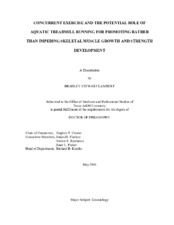| dc.description.abstract | The preservation of skeletal muscle mass, strength, and aerobic capacity have been demonstrated to be essential for maintaining one’s health, preventing a wide range of cardio-metabolic diseases, and improving quality of life. Therefore, the American College of Sports Medicine prescribes a combination of both aerobic and resistance exercise for promoting optimal health. However, previous investigators have reported that aerobic training may interfere with skeletal muscle hypertrophy and strength development when performed concurrently with resistance training as opposed to performing resistance training in isolation. Within skeletal muscle, this interference has been hypothesized to occur as a result of competing intracellular factors within skeletal muscle which are regulated by energy balance, insulin signaling, and contractile activity. However, due to inconsistencies in the literature with regards to exercise mode, frequency, intensity, training volume, and subject population, certainty about exercise interference remains unclear. Recent findings from our laboratory indicate that aquatic treadmill (ATM) running, unlike standard land treadmill (LTM) running, may enhance rather than impede skeletal muscle growth and strength while additionally providing aerobic benefits.
In the investigation presented herein, we examined the exercise-induced adaptations to 12 weeks of concurrent resistance and ATM training (RT-ATM), concurrent resistance and land LTM training (RT-LTM), and resistance training (RT) alone in previously untrained subjects. Additionally, we utilized isotope labeling to analyze the acute effects of each on myofibrillar fractional synthesis rates. From our available tissue samples, we also elected to measure chronic alterations in the content of signaling proteins hypothesized to play a role in exercise interference: protein kinase B (Akt), mammailian target of rapamycin (mTOR), and tuberous sclerosis complex 2 (TSC2) content.
Compared to RT and RT-LTM, concurrent RT-ATM exercise was found to enhance myofibrillar fractional synthesis when performed immediately following resistance exercise in the untrained state. These findings were concomitant with greater increases in lean mass and muscular strength following 12 weeks of training. Interestingly, RT-LTM training was found to yield greater reductions in fat mass than RT or RT-ATM training. Neither RT-LTM nor RT-ATM training was found to experience interference with strength or hypertrophy compared to the RT group.
The results of this investigation challenge the view that training for both strength and endurance are universally incompatible. They also highlight the importance of exercise mode selection when prescribing exercise programs for specific health or performance outcomes. In combination with RT, the novel use of ATM running may benefit those who desire to preserve strength and muscle mass while also promoting aerobic fitness. | en |


